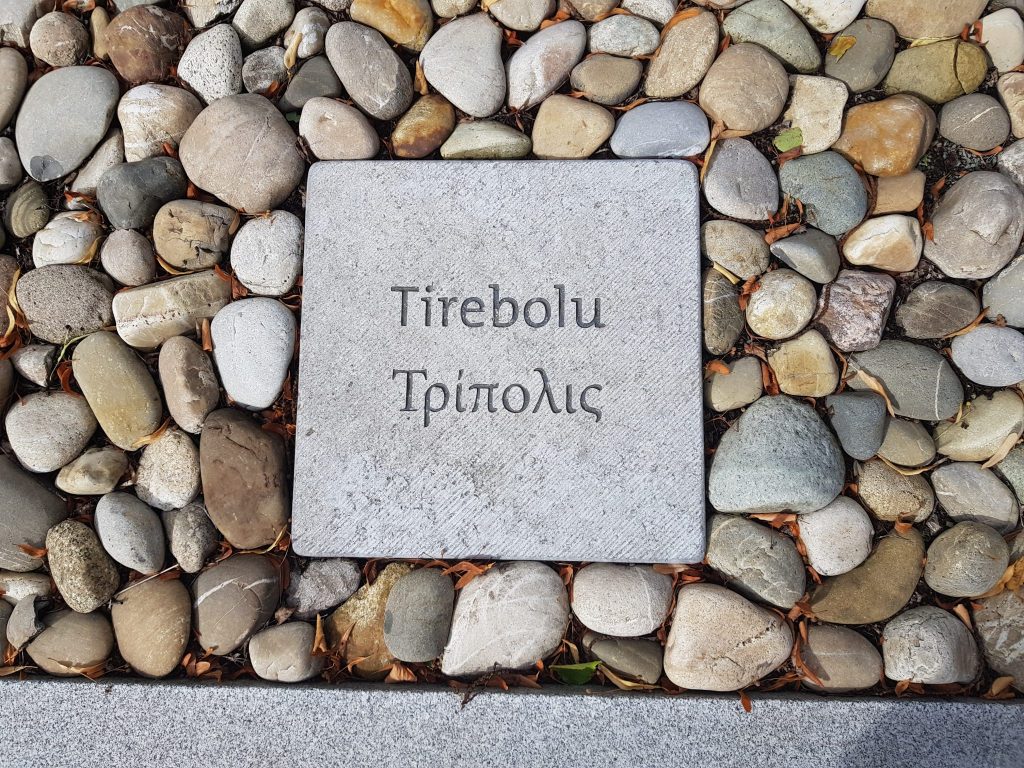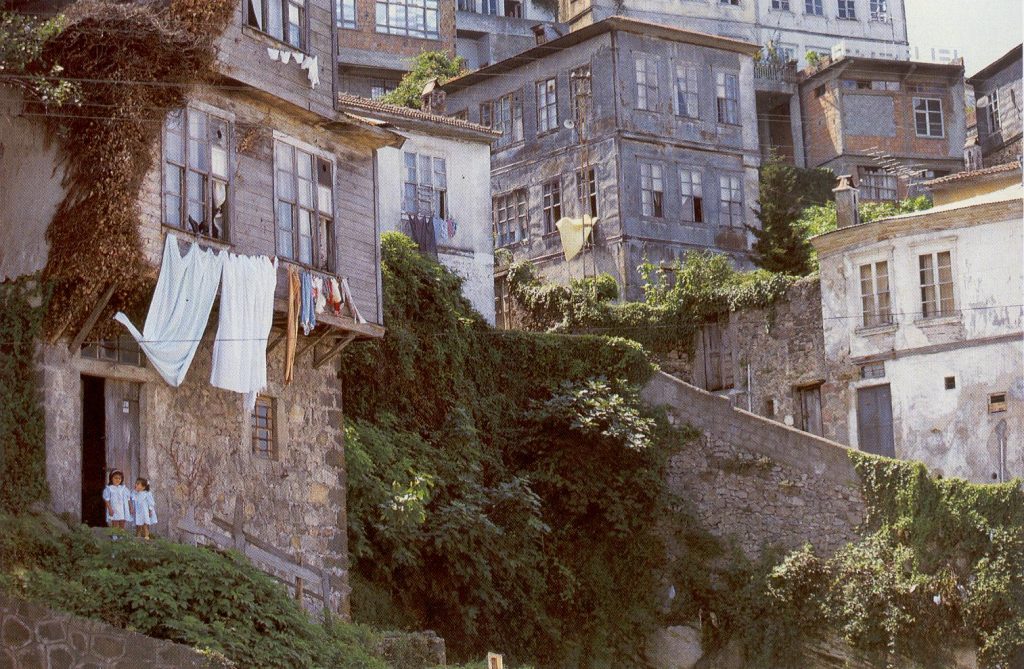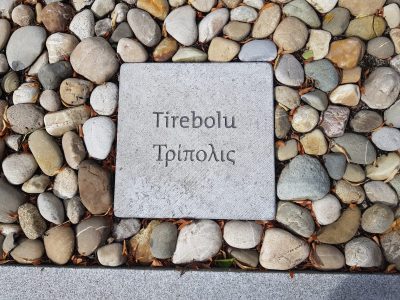

Toponym
The Greek place name Tripoli(s) means ‘three cities’. In Roman times this included Tripolis proper, Andoz (near Espiye today), Bedrama (Örenkaya) and Ayana (today’s Tirebolu), which was the administrative unit name in the period. The location of Ayana, where the present district center is located, must be the city of Isxopolis mentioned by Strabon (1st century). Ayana Castle is the castle in the town center, still marked in French as ‘Saint Jean’. Under Ottoman rule the toponym was Turkified; for 1515 the place name Direboli (Tireboli, Tirebolu) or Triboli is documented.[1]
Population
According to the Pontic Greek linguist and folklorist Dimosthenis Oiconomidis (1858-1938), around the middle of the 19th century, there were 600 families living in the town of Tripoli of which 200 were Greek (2,472 Greeks and 4,115 Turks). According to Leon Maccas, the entire district of Tripoli including its surrounding settlements were inhabited by 49,528 people of whom 17.821 were Greeks (approx. 36%).[2]
863 Armenians lived in the kaza of Tireboli, „who were very active in commerce”.[3] The Armenian community maintained one church.[4]
List of Greek Settlements in the Tirebolu Region
https://pontosworld.com/index.php/pontus/settlements/176-tripoli
History
In his Anabasis, the ancient Greek historian Xenophon (431–360 BC) wrote that Colchians, Drilae, Habibs, and Tiberians had been living in the eastern parts of the Black Sea region during the centuries B.C. The Naturalis Historia of Pliny the Elder recounts that the ancient fortress city of Tripolis was founded (656 BC) as a trading colony of the Ancient Greek city-state of Miletos, one of nearly 90 along the Black Sea coast. Due to its poor connection to the hinterland, Tripolis remained commercially relatively insignificant.
From 1204 it was a personal fief of the Comnenian emperors of Trebizond. With the conquest of Trebizond by Mehmed II in 1461, the place became part of the Ottoman Empire under the name Driboli. Then the town became part of the Nahiye of Kürtün, which was inhabited by Çepni Turkmen. The Turkish traveler Evliya Çelebi, who visited Driboli in 1640, reports about an ancient fortress and a flourishing city inhabited by Greeks.
It was occupied by Russian troops during the First World War from 1916 to 1918, which caused the Muslim inhabitants to flee. The Greek population was deported to Şebinkarahisar (Vilayet Sivas) from 1916 on.
Destruction
“The Young Turks used the advance and encampment of the Russian army in the coastal region near the mouth of the Charsiotis (Karsit) River adjacent to Tripolis and close to the inland town of Cherianna [Χεροίανα; Trk.: Şiran], as an opportunity to do away with the disturbing presence of dangerous Greeks in the wealthy provinces of Tirebolu and Kerasun [Giresun]. Claiming that there was a possibility of collaboration between Christians and Russians, they decided to deport the Greeks on a military pretext.
The first deportation, involving Greeks from the Tirebolu area, took place between November 3 and 16, 1916. In her book Η Τρίπολη του Πόντου (Tripolis of Pontos), Tatiana Gritsi-Milliex gives an account of the facts by putting documents written by Chatzigiorgis Dimitriadis and Miltiadis Langidis to good use:
‘On November 8, the firman [edict] was issued; on the 13th it was posted; by the 16th, the entire Greek population of Tripolis had to leave their homes, land and boats behind. In the same earth on which they had given birth to their children, worked for their living, enjoyed life and loved, the Greeks of Tripolis had to bury the large heart of their small population, still hanging on to their faith and their homeland, invincible and proud.
Not one Greek of Tripolis accepted Islamization; not one of them chose to give up their religion to save their lives.
The white death march lasted twenty-five days. On December 9, it was officially announced to the deportees that the Armenian village of Birk, which was uninhabited, as the 500 families who had been living there had been slaughtered by the Turks one year before, was to be their new permanent residence….
The climate in the village did not seem good to us. The water was briny; even the sick, burning with fever, were unable to drink it. Yet, our need to stick together and be close to each other in order to face our destiny made us all stay in Birk, which became a vast cemetery for thousands of Christians; Birk, whose memory calls to mind a huge, wooden cross; Birk, where we had to leave what we cherished the most: our elderly fathers and young babies, our mothers and our wives.
People lived in the same home as the dead. Those who had passed away were actually happier than the living, who were dead inside. Three months had passed since the dreadful day on which we entered Birk. It was the beginning of March, and of the 13,000 we had been when we started out, only 800 of us were left, weak and incapable of work. Of the 800 survivors, 300 were city folk; the rest were peasants.’
Regarding the same events, Georgios Sakkas, the historian of Tripolis who dedicated his life to Pontian Hellenism, testifies:
‘The hardships we had to suffer during those four months were terrible; unaccountable; beyond description.
These four months marked the most hideous period we had been through during our long history in the region. Later, we learned the enormity of our plight, and that death had taken a heavy toll on the unfortunate families who had settled mainly in Birk [now ruin; near Konakpınar] and Kolisar.
During that tumultuous period of agitation, I witnessed the extinction of whole families; a fact that was later officially verified.
A lot took place before our very eyes. We witnessed events, the memory of which awes and affects our soul deeply. We have witnessed, lived and suffered events whose memories, even today, seem unbelievable and impossible; we often catch ourselves wondering if these events actually occurred or whether they were concocted by a perverse mind. For four months we lived in suffering; death was our permanent companion in this tragedy without end’.”
Quoted from: Fotiadis, Konstantinos Emm.: The Genocide of the Pontian Greeks. Monee/Ill., 2019, p. 182f.
